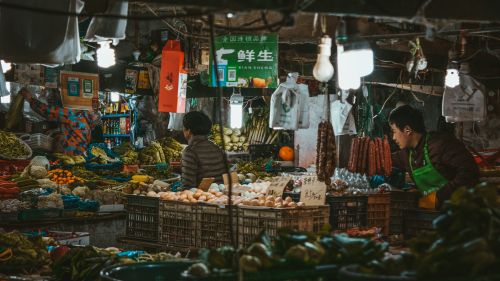China's Policies Will Reshape the Global Food System Long Past COVID-19

China is looking beyond the current environment to shape the global food system for its own food security.
A Flurry of COVID-19 Food Trade Measures
High food prices in many parts of the world are compounding the economic woes already brought on by the global pandemic. According to the UN Food and Agriculture Organization (UN FAO), food prices remain 33.9 percent higher than last year. Consumers in emerging and low-income markets that are more import-dependent will be affected most by food inflation.
Meanwhile, dozens of countries have put in place temporary restrictions on food trade. Argentina temporarily suspended maize exports, Ukraine put a cap on its maize exports, and Korea applied a tax to discourage grains exports. Many other governments are increasing production support for grains in the form of direct farmer payments or input subsidies. Amidst COVID-related measures, unexpected surges in grains purchases by China had consequences for global distribution and increased the global price of grains for food import-dependent countries. China’s latest Five-Year Plan and related policies make clear that China is looking well past the current environment to shape the global food system in ways that support its own long-term food security.
Keeping the Grains Balance over the Long Term
China is not facing unusual supply disruptions or a looming food shortage. Grain output in 2020 reached a record high of 669.5 million tons, exceeding the new official target of 650 million tons. At the same time, due to rising incomes and diversifying diets, China has become the world’s largest importer of food, surpassing the European Union and the US with imports totaling US$ 133.1 billion in 2019.
Beijing defines food security as relative balance in domestic demand and supply of grains. China’s recently announced food security policies are therefore designed to protect China’s farmland dedicated to these crops, to accelerate the development and commercialization in China of gene-edited seeds, and to ensure China’s farmers maintain production while making bigger gains in yields of wheat, rice, maize, and soybeans.
To achieve a grains balance, the government has long maintained controls over domestic grains production, stock levels, and imports. It makes annual adjustments to the prices at which it will guarantee purchases to incentivize its farmers. The country continues to build massive stockpiles equivalent to almost half of the globally available reserves of wheat, rice, maize, and soybeans.
Pay More, Store More
China recently announced plans to continue to raise the minimum purchase prices for wheat and rice and “fine-tune” its direct payments to corn and soybean producers, despite the fact that China lost a case against it in the WTO for violating its obligations to limit payments to farmers. Input and crop insurance subsidies are also set to increase. According to the OECD, China spent US$ 185.9 billion in farm subsidies in 2019 -- more than the EU, the US, and Japan combined -- making it the world’s largest subsidizer of agriculture. Under its new policies, spending will climb even higher.
Paying above international prices incentivizes farmers to produce more than they might at lower market prices. When grain market prices fall below the minimum, farmers can sell directly to state enterprises at the minimum price. Those purchased grains are placed in temporary reserves in central, provincial, or local stockpiles in the government’s attempt to stabilize prices by absorbing oversupplies that would depress market prices. The price gap between China’s domestic commodity prices and international market prices in turn encourages lower-priced imports. To further stabilize prices, the government purchases imports to put into the reserves. The result: excessive stockpiles from both domestic and foreign purchases, and fewer grain supplies available in global reserves.
According to the Agricultural Market Information System (AMIS) database, China holds nearly half of all global reserves of wheat, maize, rice, and soybeans. Although China auctions its reserves for domestic consumption, the sheer volume in its control translates to thinner reserves available for broader global food security. The opacity surrounding the size and quality of the reserves also leaves open questions about how much China needs to maintain “adequate” stocks.
Innovate Faster and Reduce Reliance on Foreign Distribution
A key pillar in China’s new food security strategy is to “speed up innovations” in seed technologies through biological breeding, gene editing, and synthetic biology. The government appears to be taking steps to greenlight the commercialization of homegrown genetically modified crops, after years of keeping similar foreign crops out of its market. Seed innovation has become critical enough to be referred to by government officials as the “microchip of agriculture.”
These approaches are designed to increase yields through producer incentives and seed innovation while reducing China’s reliance on imports, which are vulnerable to global supply shocks and geopolitical tensions such as the trade war with the United States and its subsequent tariffs on agricultural products. In part, China can do this by lowering tariffs on non-grains food imports through free trade agreements. It could also allow private commercial buyers to fill China’s annual quotas on grains that may be imported at lower tariffs.
To hedge its bets, China has created another avenue that will take on more importance over the coming decade. Through state-owned China Oil and Foodstuffs Corporation (COFCO), the government has effectively bought its way into the insular world of global grain distribution that has been dominated for decades by multinational giants ADM, Bunge, Cargill, and Louis Dreyfus.
COFCO’s international arm, CIL, acquired agricultural assets in 26 countries across a full spectrum of supply chain activities from production to processing, to logistics and transportation. These capabilities help to secure redundancy in foreign sourcing of grains, meat, and other resources critical to China’s long-term food security. For example, when tariffs made US soybeans too expensive, CIL was critical in pivoting to Brazil for soybean sources.
Grains Trade Will Look Different
China’s approach to achieving food security by paying more in subsidies to grains producers, stockpiling domestic and imported grains, approving new grain seeds, and playing a bigger and more direct role in grains distribution will all have significant implications for the global food system.
When markets function well, international trade can fill the gap between a country’s demand for food and its long-term capacity to produce sufficient food. Countries with comparative advantage in certain crops can export to increase farm incomes. They can then import to improve nutrition and dietary diversity. While many developing countries have become important grain exporters, grain imports by developing countries have also risen, increasing the importance of free trade flows of these staples for food security.>
Beijing has a right and duty to ensure food and nutrition security for its growing population. Yet China’s national strategy could change trading patterns, reduce the stocks of global food staples, and influence international prices. Other countries would also be right to ask whether China’s policies will undermine the food security of their citizens. Long after COVID-19 and other crises have receded, Beijing’s vision for how China will feed itself will affect how the rest of the world does the same.
This blog is derived from Durkin’s paper, More is less: How China’s Policies could Weaken Global Food Security, which can be accessed at the Hinrich Foundation.

